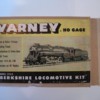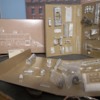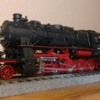As some of you know, I have a side hobby of dabbling in vintage HO. By "vintage", I mean anything from the advent of boxed HO sets up through the 1950s and 1960s. (To me, the 1970s ushered in the "Boxed Junk" era" that I'm not too interested in.)
The above parameter outlined, I would like to ask those of you that are also interested in vintage HO: What mfg'er do you think made the "best" steam engine? By "best", I simply mean ran acceptably smooth, looked good, etc.
From what I've seen (pictures), Varney made some nice looking ones, as well as Gilbert. Not too familiar with Tyco steam engines of the above era's, but I think they also made some good looking steam engines? (Gotta' forgive me, as a lad I was a diesel kid!)
Here's a pic of the Varney Berkshire. (Disclaimer: I don't know if this engine was offered RTR in a boxed set?) To me, that is ONE FINE looking steam engine, especially for the 1950s AND HO to boot!
Thus, I have zero experience with vintage HO steam... so I'm all ears! What say, oh ye wise ones?




























